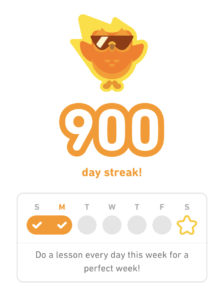 tlhIngan Hol vIHaDtaH qaStaHvIS Hutvatlh jaj = I have studied the Klingon language for nine hundred days.
tlhIngan Hol vIHaDtaH qaStaHvIS Hutvatlh jaj = I have studied the Klingon language for nine hundred days.
This is a follow-up to my 800 Days of Klingon and my Two years of Klingon lessons essays.
I still have the impression that the older, deleted form of Duolingo’s Klingon course was superior. As I predicted, I’ve hit some lessons for which the lack of explanatory essays makes it more difficult to go through them.
The ones who maintain the Duolingo Klingon course have added Guidelines for all the language units. However, these Guidelines consist solely of examples, with no other explanations.
Here are some issues that are fresh in my mind:
- Relative clauses; e.g., in the phrase Dujmey tI’laHbogh qoq’e’ vIchenmoHlaHbe’ = “I cannot create a robot which can repair ships”, Dujmey tI’laHbogh = “which can repair ships” is a relative clause. That’s indicated by the -bogh suffix on the tI’laH (tI’ = to repair, -laH = can). If you had trouble following that, so did I. This is hard to pick up solely from the Guideline examples. I was lucky here, in that the use of -bogh is covered in The Klingon Dictionary. However, the explanation there is brief, and doesn’t seem to cover all the exercises in the Unit.
-
Klingon toes. Learning the names of body parts is a basic part of any language, and the words for arm (DeS), leg (‘uS), eye (mIn), etc., were covered in an earlier lesson.
However, Klingons have names for individual fingers and toes. These names have no particular connection to any other part of the Klingon language nor to each other. They’re mostly novelty:
marwI’ = the big toe (piggy went to MARket)
HomwI’ = the second toe (piggy stayed HOME)
roSwI’ = the middle toe (piggy had ROAST beef)
nanwI’ = the fourth toe (piggy had NONE)
Qay’wI’ = the little toe (piggy CRIED)
yaD = a toe The subject of toe names is not in The Klingon Dictionary. It’s mentioned in an obscure article in HolQed. Nothing will get you through the lessons on toes except for brute-force memorization. According to “Klingon lore”, the topic is made relevant because Klingons apparently have more flexible toes than Terrans, and have phrases based on that: jaghwI’Daq jIHom = lit. “I point my second toe at my enemy” means “I claim my enemy is unworthy or weak.” I feel that that this topic is simply too obscure to be worth including in a Klingon language course. Did I really have to struggle through five lessons on Klingon toes? - Lots of endless, random repetition. One set of lessons might be on math. Then the next set might be on locations. Then the next set might be on relative clauses. Then the next set might be on locations again. The next on fingers and toes. Then another set of math lessons. In the older format, all the math lessons (for example) would be in one place. If I needed a refresher on the syntax of Klingon arithmetic (e.g., cha’ boq wej; chen vagh = “Two plus three equals five”) I could just click on the Tips of that Unit. Now these lessons are distributed all throughout the “yellow brick road” of lesson groups, with no indication of which lessons or Guidelines cover which topics. Oh, and Klingon math is also from an old HolQed article, and is not found in The Klingon Dictionary.
As I type this, I’m the middle of Unit 28 in a course that has 42 Units. Assuming that each Unit has approximately the same number of lessons, then I’ve got another year and two months before I finish the entire course.
Once again, I know that Klingon is fictional. I’m doing this for my own entertainment. I just wish that Duolingo hadn’t smashed a working lesson model into something that was not as entertaining, and for no apparent logical reason.
I wonder how the people studying Latin via Duolingo are doing?
We’ll revisit this topic on August 23, 2023; that’s 100 days from now.